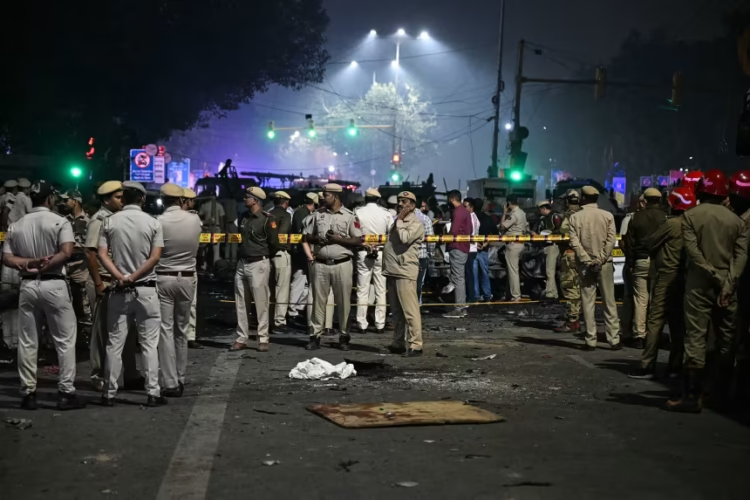Families of the victims hold vigil at LNJP, demanding swift justice.
NEW DELHI (India CSR): A powerful explosion rocked a bustling area near India’s historic Red Fort in New Delhi on Monday evening, claiming at least eight lives and injuring up to 24 others. The blast, which originated from a parked or slow-moving car outside Gate No. 1 of the Red Fort Metro Station, ignited multiple vehicles and sent shockwaves through the densely populated Chandni Chowk district. Authorities have launched a multi-agency investigation, probing potential terror links amid heightened national security concerns. Prime Minister Narendra Modi has been briefed, and a high alert has been issued across Delhi, neighboring Uttar Pradesh, and Maharashtra. Rescue operations concluded late evening, with the site now secured for forensic analysis.
Incident Details
The explosion occurred at approximately 6:52 PM IST, during peak evening traffic near the Lal Quila Metro Station, a key transit hub adjacent to the 17th-century Red Fort—a UNESCO World Heritage site and symbol of India’s independence struggle. Eyewitnesses described a deafening blast that felt like an earthquake, with one local shopkeeper recounting: “I never heard such a loud explosion ever in my life. I fell three times due to the explosion. It felt as if we were all going to die.” Another injured auto-rickshaw driver, Zeeshan, who was just two feet from the vehicle, identified it as a white Maruti Swift Dzire sedan. “I don’t know whether there was a bomb in it or something else, but it exploded,” he told reporters from his hospital bed.
The high-intensity detonation shattered nearby window panes, scattered debris—including reports of body parts—and triggered a chain reaction fire that engulfed three to four additional vehicles. Videos circulating on social media captured plumes of black smoke billowing from the site, panicked crowds fleeing, and emergency sirens piercing the chaos. The Delhi Fire Services (DFS) received the alert at 7:05 PM and dispatched seven fire tenders, extinguishing the blaze by 7:29 PM.
Casualties and Medical Response
Official tallies from Delhi Police confirm eight fatalities, with victims including pedestrians, motorists, and possibly occupants of the exploded vehicle. Injury figures range from 6 to 24 across reports, with 15 individuals admitted to Lok Nayak Jai Prakash (LNJP) Hospital for treatment of burns, shrapnel wounds, and blast trauma. Ambulances, including 15 CAT units, ferried the wounded from the scene amid initial confusion. No official breakdown of victim demographics has been released, but the area’s heavy footfall—tourists, commuters, and locals—suggests a diverse toll.
| Category | Confirmed Figures | Notes |
|---|---|---|
| Deaths | 8 | Includes possible vehicle occupants; autopsies pending. |
| Injuries | 6–24 | Primarily burns and lacerations; stable conditions reported. |
| Hospitals | LNJP (primary) | Overcrowded; additional transfers to Ram Manohar Lohia Hospital. |
| Missing | None reported | Search operations complete. |
Emergency and Security Response
Delhi Police Commissioner Satish Golcha addressed the media shortly after the incident, stating: “Today at around 6:52 pm, a slow-moving vehicle stopped at a red light. An explosion happened in that vehicle, and due to the explosion, nearby vehicles were also damaged.” The site was swiftly cordoned off, with traffic diverted and metro services briefly disrupted. Specialized units—including the National Security Guard (NSG), National Investigation Agency (NIA), Forensic Science Laboratory (FSL), and Delhi Police Special Cell—deployed bomb-sniffing dogs, drones, and disposal squads to scour for secondary devices.
A high alert was sounded across the National Capital Region (NCR), with Uttar Pradesh Police instructed to intensify vehicle checks at borders and Mumbai authorities enhancing vigilance at key installations. Prime Minister Modi, currently in New Delhi, received a detailed briefing from Union Home Minister Amit Shah, who assured “all possible support” to local responders. Delhi Chief Minister Arvind Kejriwal visited LNJP Hospital to meet the injured and families of the deceased.
Investigation and Potential Causes
The probe remains in early stages, with investigators treating the blast as suspicious. Preliminary findings point to an improvised explosive device (IED) concealed in the vehicle, though accidental causes—like a gas cylinder malfunction or industrial mishap—are not ruled out. The timing raises alarms: Just hours earlier, Haryana Police dismantled an interstate terror module in Faridabad, seizing 2,900 kilograms of ammonium nitrate—a key explosive precursor—linked to banned outfits. While no direct connection has been established, counter-terror experts note the Red Fort’s symbolic value as a potential target.
Forensic teams collected residue samples amid charred wreckage, with CCTV footage from the metro station and surrounding streets under review. “All angles are being probed, including terror links,” a senior NIA official said anonymously. No group has claimed responsibility, and the vehicle’s registration—traced to a rental firm in Uttar Pradesh—is being verified for ownership details.
Background and Context
New Delhi’s Old City, encompassing the Red Fort and Chandni Chowk bazaar, is a vibrant economic artery teeming with over a million daily visitors. The Red Fort, built by Mughal Emperor Shah Jahan, has long been a flashpoint for security: It hosted Independence Day addresses until 2023 disruptions and was the site of a deadly 2021 farmers’ protest clash. India has faced sporadic urban blasts, including the 2008 Delhi serial bombings (over 30 killed), but major incidents have declined amid robust intelligence reforms post-26/11 Mumbai attacks.
This event unfolds against a backdrop of escalating regional tensions, including cross-border skirmishes with Pakistan and internal threats from insurgent groups. The ammonium nitrate seizure earlier today underscores vulnerabilities in chemical supply chains, echoing the 2020 Beirut port explosion that killed 218.
Global Reactions and Implications
International leaders expressed solidarity, with U.S. President Joe Biden’s office calling it a “heinous act” and offering FBI assistance if needed. The European Union and United Nations reiterated support for India’s counter-terror efforts. On social media, #DelhiBlast trended globally, amassing over 500,000 posts in hours, blending condolences with speculation.
For global audiences, this incident highlights urban security challenges in megacities: The Red Fort’s proximity to public transit mirrors vulnerabilities in sites like London’s Westminster or New York’s Times Square. Travel advisories for India remain unchanged, but tourists are urged to avoid central Delhi amid ongoing probes. Economically, the blast could disrupt Diwali-season commerce in Chandni Chowk, a $2 billion annual hub.
Outlook
As dawn breaks on November 11, Delhi’s streets near the Red Fort remain eerily quiet under heavy patrols. Investigators anticipate breakthroughs from forensic results within 48 hours, potentially clarifying if this was a lone-wolf act, organized terror, or tragic accident. Families of the victims hold vigil at LNJP, demanding swift justice. In a city of 33 million, resilience prevails—but this shadow over the capital serves as a stark reminder of fragility in an era of asymmetric threats.
(India CSR)








